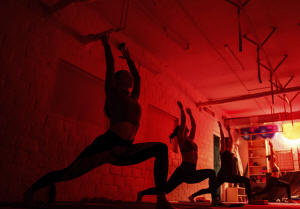Which style of yoga is right for me? Here’s a primer, with a caveat
 Send a link to a friend
Send a link to a friend
 [January 27, 2025]
By ALBERT STUMM [January 27, 2025]
By ALBERT STUMM
To some people, the word “ yoga ” evokes ritualistic chanting, long
breaths and slow movement. To others, it means contorting your body into
ever more complicated positions until sweat drips onto the mat.
In reality, it can be both — with a lot of variation in between. It
depends on the teacher, who could be trained in several of numerous yoga
styles: hatha, vinyasa, Iyengar, ashtanga, yin and more.
Though all styles involve poses (asanas), they differ in significant
ways. Even classes within the same style can range from calming to
vigorous.
So what is the best type of class for a beginner?
“The best is the one that works for you,” said Tim Senesi, who has been
teaching yoga in Orange County, California, for 22 years. “There are
many different paths leading toward the same aim.”
Here’s a primer on some of the most popular styles, followed by a big
caveat.
The hatha/yin yoga styles
The term “yoga,” which is derived from the Sanskrit for “union,”
actually encompasses an entire discipline that includes movement,
meditation and lifestyle. Hatha, meaning “force,” technically is any
kind of yoga class involving asanas. If you’ve ever heard of a sun
salutation, for instance, that is a foundational sequence of 12 asanas
that begin many types of classes.
When it comes to classes listed as hatha, however, they generally are
gentler with more focus on breathing exercises (pranayama). Poses are
held for a few breaths and students usually move more slowly.

Hatha can be good for beginners who are looking to relax while improving
flexibility and balance.
Another style, yin, is even more focused on recovery by working to
stretch the muscles’ connective tissue. Students hold poses for 5
minutes or more, allowing the body to settle into a pose rather than
pushing it.
The vinyasa/ashtanga styles
A more vigorous, flowing form of yoga, vinyasa coordinates movement with
breath over a progression of asanas. Some higher-level vinyasa classes
move at a pace of one movement per breath.
Often they will be called Flow or Power classes. They can be appropriate
for people who are more athletic, but teachers still recommend that
those students start with a beginner level.
[to top of second column]
|

Women attend a yoga master class at Shogun sports center in Kyiv,
Ukraine on Nov. 29, 2024. (AP Photo/Evgeniy Maloletka, File)
 “I wouldn’t really encourage them to
start in a higher level vinyasa flow class because they’re not going
to have the foundation to move safely through that,” said Anne Van
Valkenburg, of Lanai, Hawaii, who has been training yoga teachers in
a blend of styles for 18 years.
Another style, ashtanga, is similar except that it involves a set
series of poses that students repeat day after day, often going at
their own pace. As students get stronger, they advance to a higher
series with more challenging poses, something akin to belt levels in
martial arts.
The Iyengar style
This style involves the same poses as vinyasa but classes usually
move at a slower pace — although they are not necessarily easier.
The focus is more on precisely aligning parts of the body through
small adjustments. Poses are held for longer and students rely more
often on props including cushions, blocks or straps.
Iyengar is particularly good for people recovering from injuries, or
for people who are already active but want to get the foundation of
yoga before moving into different styles.
The caveat about choosing yoga styles
These days, most teachers blend various styles in their classes, and
many classes aren’t billed with these terms. The few words
describing the class should give you an idea of what to expect, but
don’t be afraid to ask questions at the studio or reach out to
individual teachers.
Ideally, seek out a beginner series, but if you can’t find one
that's right, don’t worry. Most teachers are happy to have beginners
in their classes and will make accommodations.
Most of all, commit to trying a few classes until you find the style
or teacher that resonates with you.
“I feel sad when someone tries yoga once or twice and they’re like,
‘Eh, I don’t like it,’” Van Valkenburg said. “There’s just so much
out there that you might be missing something that’s super
beneficial for your life.”
All contents © copyright 2025 Associated Press. All rights reserved |